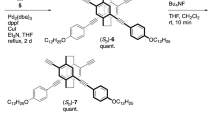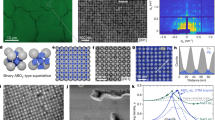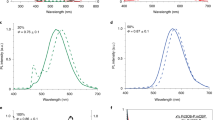Abstract
IN many photochromic systems, and certainly in the spiro-pyrans, the colourless (A) form is much less polar than the photocoloured (B) form1. Our previous experiments2,3 revealed unusual properties of spiropyrans in non-polar solvents at low temperatures (173–240 K). On irradiation of these solutions with suitable light there were formed dimers (AB) and charge transfer complexes (CTC≡An+B− with n ≃ 2–3), and these in turn formed aggregates with degrees of association >106. The CTC exhibit spectral red shift of about lOO nm as compared to the dimers. The relative populations of dirners and charge transfer complexes in the aggregates depended both on light intensity and temperature, because CTC formation involves an activation energy of about 5 Kcal mol−1 associated with the interaction of dirners with further A molecules. At temperatures sufficiently low or at light intensities sufficiently high it was possible to obtain aggregates composed of dimers only. When the constant field was applied during irradiation, threads were formed which extended from one electrode to the other (along the electric lines of force). These threads are composed of dimers and CTC, and their absorption spectrum is identical to that of aggregates in solution. Linear dichroism measurements showed that the CTC are oriented along the thread axis, but the dimers are unoriented. These threads were formed only in the temperature range in which CTC arise in solution. Here we describe investigations of the structure of such threads, which led us to conclude that the threads consist of highly dipolar crystallites composed of the charge transfer complexes and coated by an amorphous phase composed of dimers. These crystallites in the amorphous envelope are oriented along the electric field and joined together to give the quasi-crystalline threads.
This is a preview of subscription content, access via your institution
Access options
Subscribe to this journal
Receive 51 print issues and online access
$199.00 per year
only $3.90 per issue
Buy this article
- Purchase on Springer Link
- Instant access to full article PDF
Prices may be subject to local taxes which are calculated during checkout
Similar content being viewed by others
References
Bertelson, R. Photochromism ch. 3 (ed. Brown, G. H., Wiley, New York, 1971).
Krongauz, V. A. & Parshutkin, A. A. Photochem. Photobiol. 15, 503 (1972).
Parshutkin, A. A. & Krongauz, V. A. Molec. Photochem. 6, 437 (1974).
Koelsch, C. F. & Workman, W. R. J. Am. chem. Soc. 74, 6288 (1952).
Jaffe, J. H., Jaffe, H. & Rosenhek, R. Rev. Scient. Instrum. 38, 935 (1967).
Mees, C. E. & James, T. H. Theory of the Photographic Process ch. 11 & 12 (Macmillan, New York, 1966).
Author information
Authors and Affiliations
Rights and permissions
About this article
Cite this article
KRONGAUZ, V., GOLDBURT, E. Quasi-crystals from irradiated photochromic dyes in an applied electric field. Nature 271, 43–45 (1978). https://doi.org/10.1038/271043a0
Received:
Accepted:
Published:
Issue Date:
DOI: https://doi.org/10.1038/271043a0
This article is cited by
-
Synthesis and structure of indoline spiropyrans of the coumarin series
Russian Chemical Bulletin (2005)
-
UV-induced self-assembly of the inclusion complexes formed between a long-chain photochromic spiropyran and cyclodextrins
Science in China Series B: Chemistry (1999)
-
Quasi-liquid crystals
Nature (1984)
Comments
By submitting a comment you agree to abide by our Terms and Community Guidelines. If you find something abusive or that does not comply with our terms or guidelines please flag it as inappropriate.



